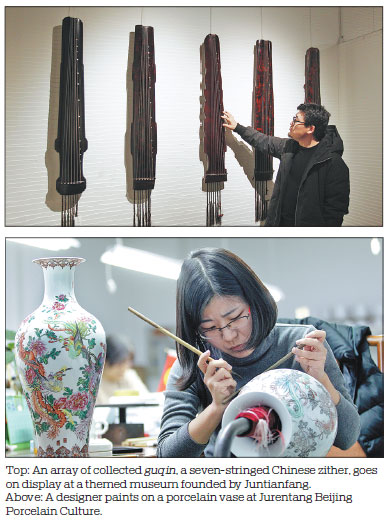Historical, cultural and creative environment thrives in capital
As a shining cultural center of China, Beijing boasts incomparably rich intangible cultural heritage - that for generations has added enduring and ineffable charm to the capital city.
One such example is its homegrown porcelain. Jurentang Beijing Porcelain Culture is a company specializing in the design, production and sale of Beijing decorative porcelain for daily use, for interior decoration and for collectors.
Beijing decorative porcelain, with a history spanning over a century, is noted for its elegant shapes as well as for its honed colors. Connoisseurs say it employs pastels, variegated color and polychrome painting, as well as enamels.
The porcelain originated in the Qing Dynasty (1644-1911) and has been listed among Beijing's intangible cultural heritage.
The porcelain is the epitome of China's porcelain culture and it plays an important role in the inheritance and promotion of history and culture, said Shi Qin, general manager of the company.
The company evolved from a handicraft factory founded in 1973, when it employed 800 porcelain artisans, Shi said.
Later, however, many of them quit the company or turned to other positions, such as property management, rather than making porcelain, as the company encountered difficulties in the market. By 2008, there were only five senior retired craftsmen left, she said.
"We had to rehire these retirees to continue making the porcelain and to pass down the skill."
In addition, the company recruited more than 20 young people at the time, with financial and resources support from the Beijing government, Shi said.
The company is the only one of its kind in Beijing and has a history of more than 100 years from the first to the fifth generations of inheritors, she added.
After nearly 10 years of training, the company has trained and cultivated several senior artisans and three inheritors, she added.
Xu Libin, director of the company's workshop and one of the inheritors, said that generally it took 72 steps to complete a porcelain product, but now the procedure has been shortened to 10 to 30 steps to save manufacturing time and costs.
Xu has been working as a designer in the company since 2009.
"This is a job that requires time and patience," he said, adding that it takes about 15 to 20 days to create a design.
The colors of Beijing-style porcelain are thick and bright and consistent with the aesthetic taste of northern China, Xu said.
"We are adhering to making the porcelain by hand to ensure the porcelain quality and to pass on this craft."
To popularize the skill, the company set up a museum in 2013 to offer the general public hands-on experience in making porcelain, visits to the production line and other innovative programs.
Liu Chuanping, deputy director of the museum, said that the museum has experienced sound development in line with the overall trend in the capital's efforts toward protecting its cultural traditions.
"There are more opportunities in intangible cultural heritage protection, as it is increasingly becoming a major trend toward inheriting traditional culture," she said.
Beijing Juntianfang Guqin Culture and Art Communication, which makes and develops the traditional guqin - a seven-stringed Chinese zither-was founded in 2001.
It takes two years to make a guqin and the company produces 500 to 600 of them every year, said Shan Lianqing, marketing manager of the company.
"The inheritance of intangible cultural heritage requires passion and spirit, and also needs financial support," he said, adding that production and sales of the guqin provides the key impetus to the craft's development as an industry.
In 2013, the company was designated as a national intangible cultural heritage protection research center and in the following year, its guqin art was listed as a representative project in the national intangible cultural heritage list.
"We develop our business model into different types based on the guqin industry," he said.
The company has developed the industry through various activities such as training, museums, exhibitions and performances.
To date, Juntianfang has trained nearly 800 students and has staged performances and exhibitions in countries including Israel, Denmark, Britain and Russia, according to the company.
"We are striving to build a museum that gives visitors an experience of vision, hearing and sensation," Shan said.
"As the capital, Beijing boasts the best cultural environment in our country, which gives us confidence to have better development here," he said.
The company will capitalize on every opportunity to inherit and introduce the traditional culture to the world, he added.

(China Daily 01/15/2019 page7)














